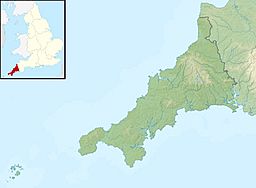Kynance Cove facts for kids
Quick facts for kids Kynance Cove |
|
|---|---|

Kynance Cove, Lizard peninsula, Cornwall
|
|
| Location | South West England, Cornwall, England |
| Coordinates | 49°58′26″N 5°13′48″W / 49.974°N 5.230°W |
| Type | Cove |
Kynance Cove (Cornish: Porth Keynans, meaning ravine cove) is a beautiful bay located in Cornwall, England. You can find it on the eastern side of Mount's Bay, about 3 kilometers north of Lizard Point on the Lizard peninsula.
This stunning cove became very popular during the early Victorian era. Even famous people like Queen Victoria, Prince Albert, and the poet Alfred Tennyson came to visit! The BBC has called Kynance Cove "one of the most beautiful stretches of coastline in the South West."
Today, The National Trust looks after Kynance Cove and the surrounding coast. It's a special place, part of the West Lizard Site of Special Scientific Interest and the Cornwall Area of Outstanding Natural Beauty. The South West Coast Path, a long walking trail, passes right by the cliffs overlooking the cove.
There's also a cafe at Kynance Cove, which first opened in 1929. When the National Trust took over the cafe in 1999, they updated it with modern water and electricity. You can reach the cove by walking along the coastal footpath from a nearby National Trust car park.
Contents
Exploring Kynance Cove's Unique Geology
The Lizard peninsula is famous for its amazing plants and rocks. Kynance Cove is a very important place for geologists (scientists who study rocks and the Earth).
How the Rocks Were Formed
About 375 million years ago, the molten rock that would become the Lizard was deep inside the Earth. It was about 10 kilometers below the surface, under extreme heat and pressure. One type of rock, called peridotite, was rich in magnesium and iron. This rock changed into serpentinite as it pushed up from the Moho. The Moho is the boundary between the Earth's crust (outer layer) and its mantle (the layer beneath the crust).
This rock mass eventually reached the Earth's surface about 30 degrees south of the equator. This happened as part of an ocean ridge in the ancient Rheic Ocean. Over the next 80 million years, the Rheic Ocean disappeared. The rock mass then moved north, crossing the equator about 250 million years ago. It passed the Tropic of Cancer less than 100 million years ago. Finally, it reached its current location at 50 degrees north around the start of the last Ice Age.
Types of Serpentinite Rocks
At Kynance Cove, you can see two main types of serpentinite rock: bastite and tremolite.
- Bastite serpentinite: This type of rock is found at the car park, on the cliffs to the south, and along the path to the cove. It's the most common type of serpentinite on the Lizard. It looks coarse-grained with large, shiny crystals that make it appear flecked.
- Tremolite serpentinite: This rock makes up the islands and stacks within the cove and the valley. It is fine-grained and has bands. Tremolite formed under even higher pressure deep within the Earth's crust.
Kynance Cove is special because it shows these two types of ophiolitic serpentinite clearly. You can also find granite and gneiss rocks mixed in with the serpentinite. Because of its unique geology, the area has been named a Geological Conservation Review site.

Islands and Blowholes
Kynance Cove has several small islands and stacks (tall, thin rock columns) that appear at low tide. These formed because the tremolite serpentinite was broken into blocks. Softer rocks like granite and basalt then filled the cracks. Over time, the sea eroded these softer rocks, leaving the harder serpentinite stacks behind.
The four largest stacks, from left to right, are The Bishop, Gull Rock, Asparagus Island, and Steeple Rock. Asparagus Island is often cut off from the mainland at high tide. It was once thought to be connected by a sand bar. However, winter storms washed the sand away, revealing a rocky ridge underneath. This ridge likely formed over 100,000 years ago when sea levels were higher.
At about half-tide, you might hear a loud snorting sound. This is the Devil's bellows, a blowhole on Asparagus Island. It's caused by the sea tunneling along a crack in the rock. There's also a second blowhole called the Post Office. It's named this because the suction from the water is strong enough to "post" a letter into it!
Wildlife at Kynance Cove
Kynance Cove is a great place to spot different kinds of wildlife. It was even the first place in Britain where a rare moth called Porter's rustic (Athetis hospes) was recorded. This moth is a rare visitor from southern Europe.


